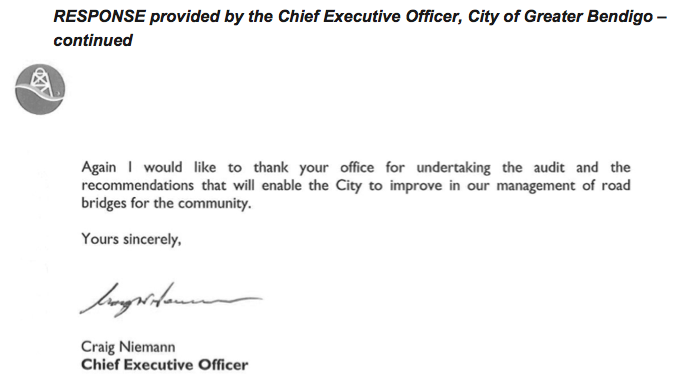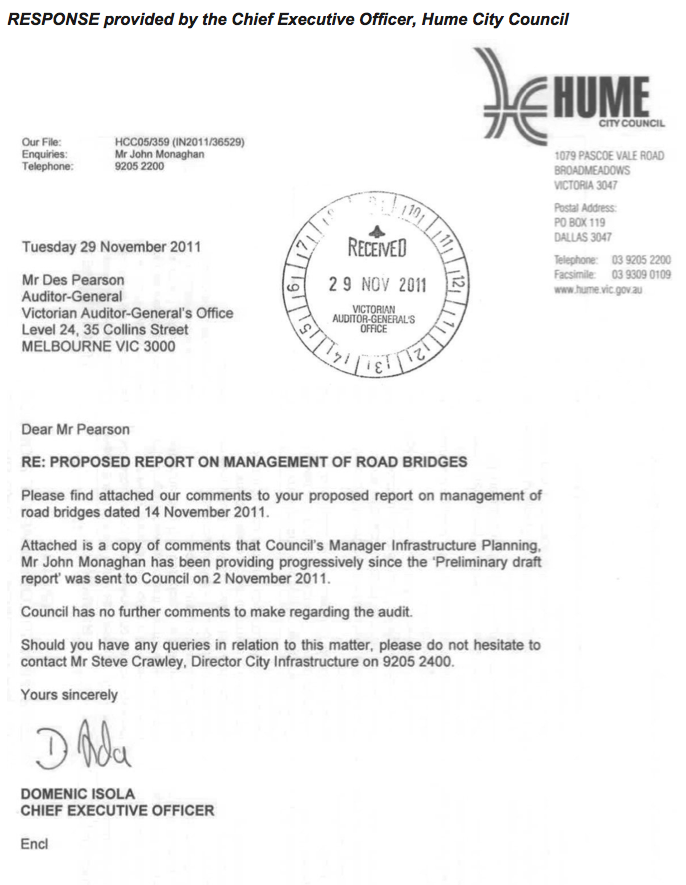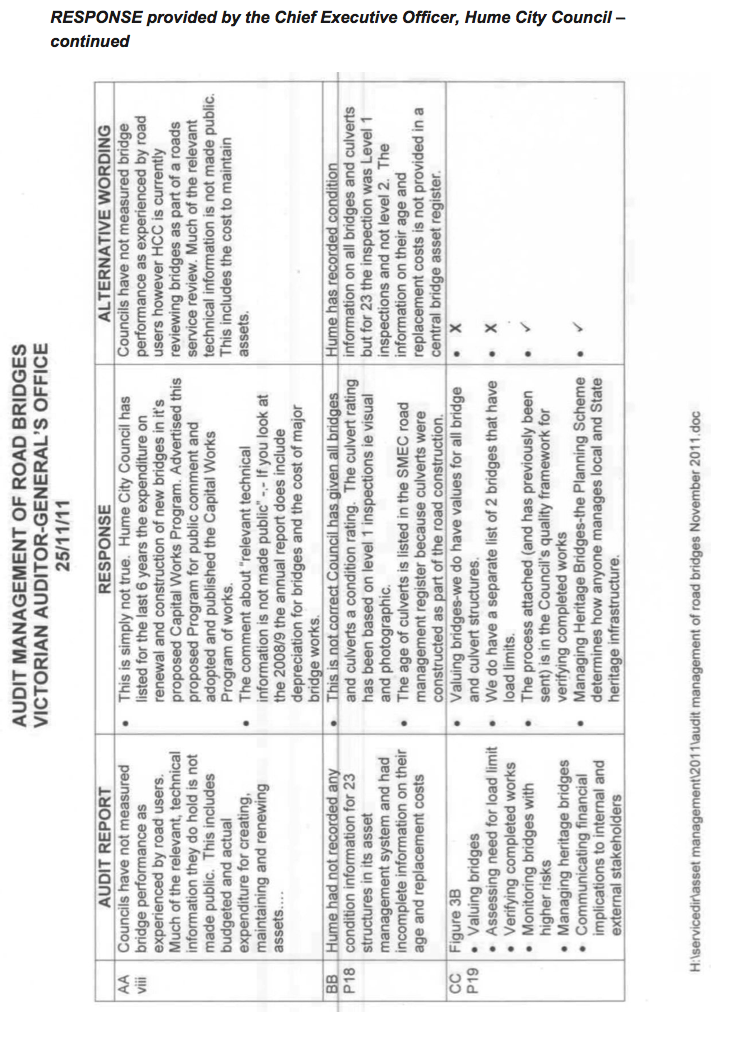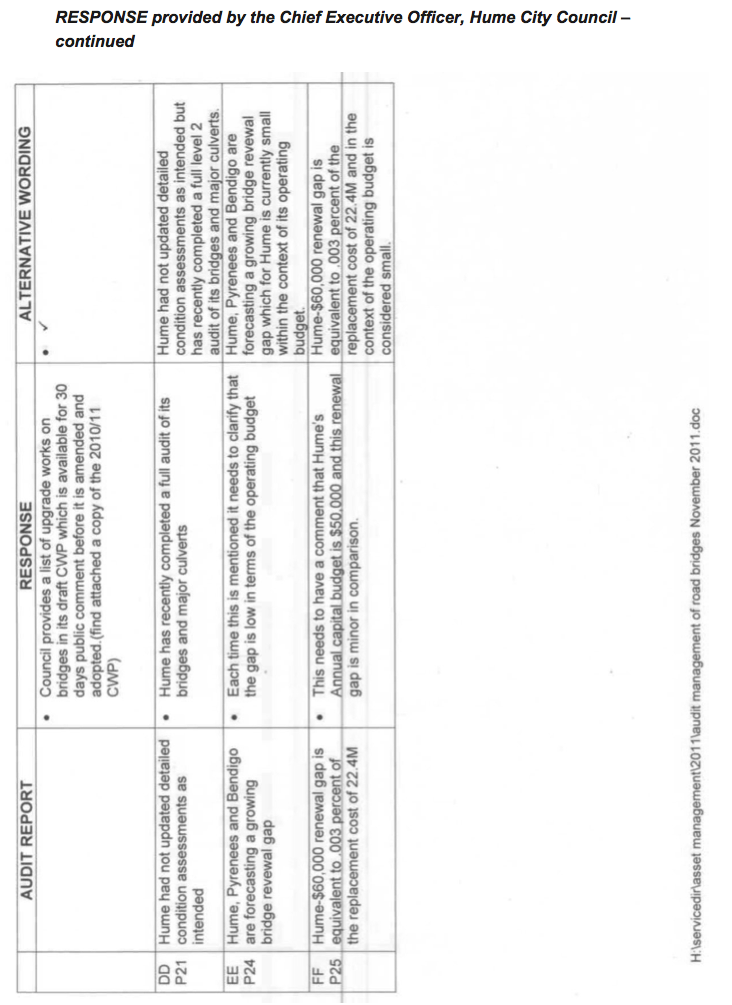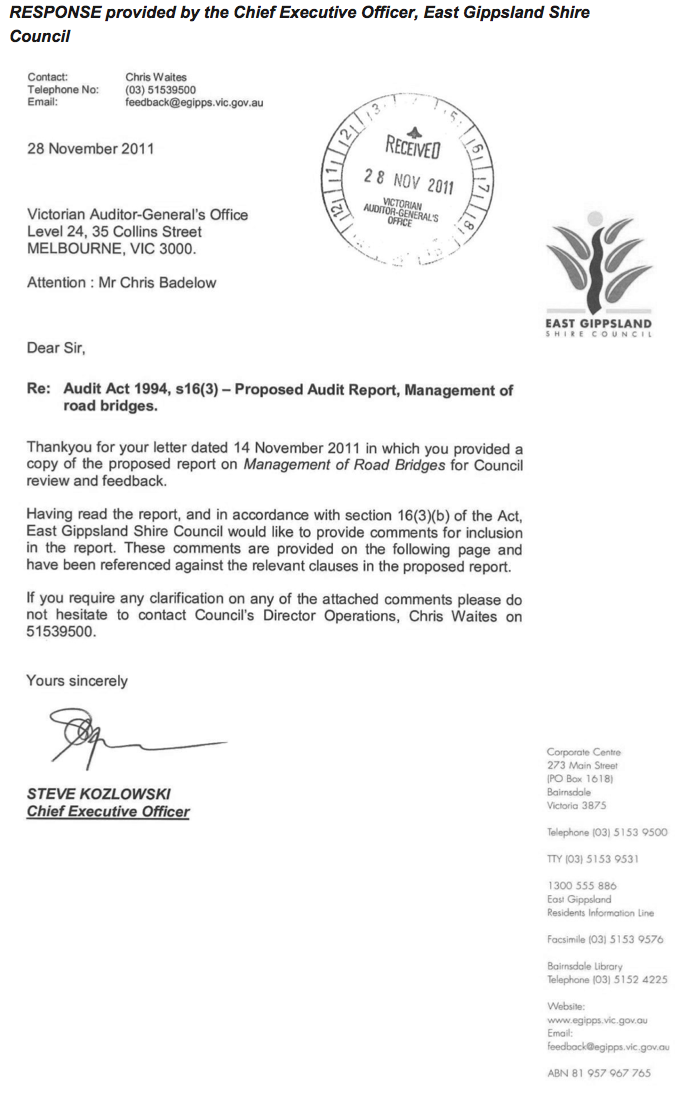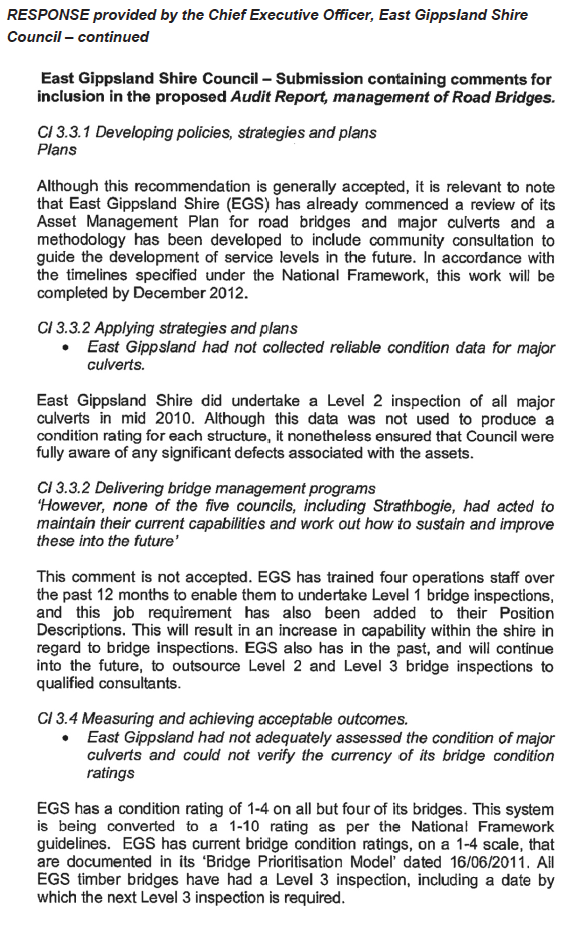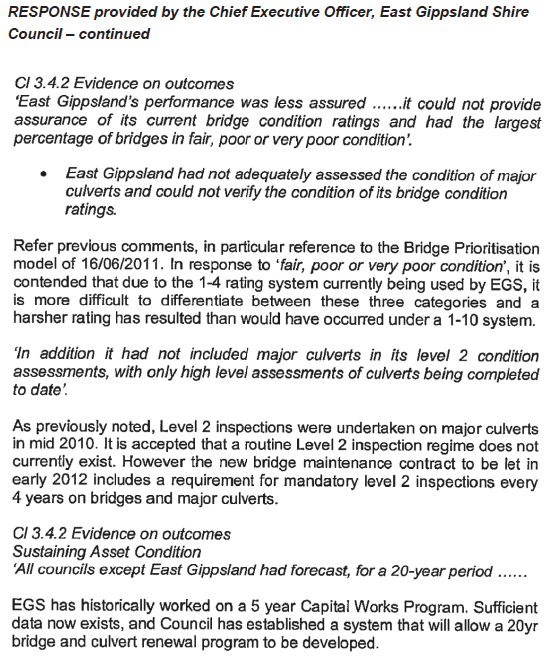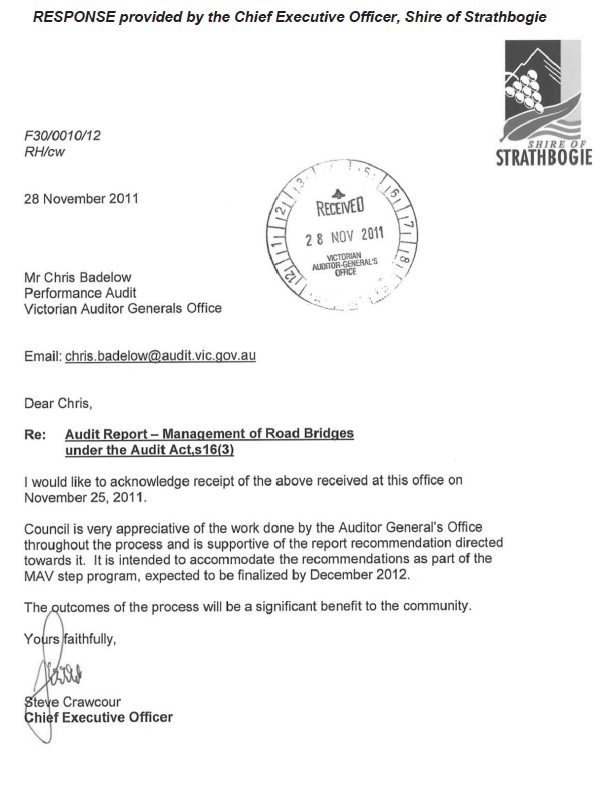Management of Road Bridges
Overview
VicRoads is effectively managing the structural safety of bridges and culverts and prioritises annual funding to the areas of greatest short-term need. However, VicRoads has not formed detailed long-term plans nor adequately measured, forecast and reported on the levels of service experienced by road users. Doing these things is a prerequisite for VicRoads to adequately inform longer-term resourcing decisions.
While councils’ bridges and major culverts have been safe to use, their approach to managing these assets limits their ability to fully assure their continued safe operation. Examples of incomplete, out of date and unreliable information on bridge condition and weaknesses in councils’ asset management processes should be addressed so that councils can demonstrate effective asset management.
Both VicRoads and local councils recognise that competition for scarce resources means there is a risk that funding falls short of the levels required to meet road users’ expectations. Agencies need to understand and manage these expectations by completing robust long-term plans, establishing performance measures and improving their public performance reporting.
Management of Road Bridges: Message
Ordered to be printed
VICTORIAN GOVERNMENT PRINTER December 2011
PP No 92, Session 2010–11
President
Legislative Council
Parliament House
Melbourne
Speaker
Legislative Assembly
Parliament House
Melbourne
Dear Presiding Officers
Under the provisions of section 16AB of the Audit Act 1994, I transmit my report on the audit Management of Road Bridges.
Yours faithfully
![]()
D D R PEARSON
Auditor-General
7 December 2011
Audit summary
Background
An efficient road system underpins economic prosperity and liveability. Bridges are critical links in the road network because they carry traffic over natural and man-made obstacles. If bridges are not properly maintained or fail to keep up with increasing demands, they become pinch points that prevent the free and efficient movement of people and freight.
VicRoads is responsible for approximately 6 000 bridges and major culverts—which channel water under roads—located on the arterial road network. The five councils included in this audit—Bendigo, East Gippsland, Hume, Pyrenees and Strathbogie—are responsible for managing a further 1 000 of these structures.
Road users have expectations about the level of service—the safety, speed, reliability, comfort and cost of travel—provided when they travel across bridges. The freight industry needs bridges that allow the flexibility to use larger, more efficient trucks on direct routes.
Effective asset management means applying plans that deliver the services the community requires cost-effectively over the lives of these assets, by:
- setting clear and comprehensive target levels of service
- forming long-term plans and annual priorities to make the most efficient use of available funding
- regularly measuring performance and forecasting how current decisions and agencies’ long-term plans are likely to affect levels of service.
The audit assessed whether VicRoads and selected councils are managing road bridges and major culverts effectively.
Conclusion
VicRoads is effectively managing the structural safety of bridges and culverts and prioritises annual funding to the areas of greatest short-term need. However, VicRoads has not formed detailed long-term plans nor adequately measured, forecast and reported on the levels of service experienced by road users. Doing these things is a prerequisite for VicRoads to adequately inform longer-term resourcing decisions.
While councils’ bridges and major culverts have been safe to use, their approach to managing these assets limits their ability to fully assure their continued safe operation. Examples of incomplete, out of date and unreliable information on bridge condition and weaknesses in councils’ asset management processes should be addressed so that councils can demonstrate effective asset management.
Both VicRoads and local councils recognise that competition for scarce resources means there is a risk that funding falls short of the levels required to meet road users’ expectations. Agencies need to understand and manage these expectations by completing robust long-term plans, establishing performance measures and improving their public performance reporting.
Findings
VicRoads
VicRoads has effectively managed the condition and use of bridges and culverts which safely convey the vehicles that are allowed to cross them. VicRoads effectively monitors their condition and has acted to repair or limit the use of bridges where further deterioration is likely put road users at risk.
VicRoads developed a comprehensive overall asset management strategy in 2002 but has yet to capitalise on this by:
- developing detailed, long-term plans
- adequately measuring and reporting on the levels of service experienced by road users or forecasting how these are likely to change under assumed funding levels.
Addressing these gaps will enable VicRoads to appropriately inform government about the challenge of maintaining ageing assets. Over 50 per cent of structures have reached or are approaching an age where they will need major repairs over the next 10 to 15 years to continue to function as intended.
VicRoads’ projects to strengthen the West Gate Bridge and invest in complementary maintenance works means that we are assured that the bridge is structurally safe, has a sound management framework and improved maintenance access. The strengthening project has provided better information about the condition and behaviour of the bridge and VicRoads needs to finalise its 15-year bridge strategy to provide meaningful guidance on how to best manage the bridge.
Councils
Councils’ management of road bridges and major culverts has been partly effective.
Bridges and culverts have been safe for road users. However, councils need to address the following weaknesses in their management of these assets if they are to be fully assured about their future safe use:
- the completeness, reliability and use of asset information, which applied to all councils in varying degrees
- all councils had gaps in their documented processes, for example, none had adequately documented how they manage high-risk structures.
In terms of performance measurement, local communities do not have access to information that allows them to understand how well councils have managed bridges and culverts.
Councils have not measured bridge performance as experienced by road users. Much of the relevant, technical information they do hold is not made public. This includes budgeted and actual expenditure for creating, maintaining and renewing assets, the rate at which bridges are depreciated and ratings of bridge condition.
Councils need to define levels of service that are meaningful to road users, set targets that take account of community expectations and publish information that measures past achievements and the expected implications of future levels of resourcing.
Recommendations
VicRoads should:
- develop comprehensive, long-term plans to manage bridges and major culverts
- quantify the impact of past actions and forecast the likely impact of forward plans on the levels of service, including the safety, speed, reliability, comfort and cost of travel
- complete a long-term maintenance strategy for the West Gate Bridge that measures levels of service that reflect the outcomes experienced by those using the bridge.
Councils should:
- define bridge levels of service that capture the outcomes that are important to road users and incorporate associated targets and measures in their plans
- publish information that will allow the community to understand councils’ performance in terms of the past and forecast costs and service outcomes
- address the information and process weaknesses identified in this report.
Submissions and comments received
In addition to progressive engagement during the course of the audit, in accordance with section 16(3) of the Audit Act 1994 a copy of this report, or relevant extracts from the report, was provided to VicRoads, the City of Greater Bendigo, Hume City Council, and the shires of East Gippsland, Pyrenees and Strathbogie with a request for submissions or comments.
Agency views have been considered in reaching our audit conclusions and are represented to the extent relevant and warranted in preparing this report. Their full section 16(3) submissions and comments, however, are included in Appendix A.
1 Background
1.1 Introduction
1.1.1 The role of road bridges in Victoria
An efficient road system underpins Victoria's economic prosperity and liveability. Roads carry 90 per cent of the freight and people that move around Victoria. Over the past decade the volume of traffic and road freight has increased sharply with:
- a 20 per cent increase in overall vehicle kilometres
- a 41 per cent increase in the weight of goods carried by road.
If bridges are not properly maintained or fail to keep up with increasing demands, they become pinch points that prevent the free and efficient movement of people and freight.
General traffic and road freight are expected to grow rapidly and this, combined with the move to larger freight vehicles, will place additional demands on road bridges.
1.1.2 Managing road bridges
Good asset management means applying plans that deliver the services the community requires over the lives of these assets in a way that is cost-effective.
At the most basic level bridges provide the means to make journeys that pass over obstacles such as rivers and railway lines. The community's expectations, however, go beyond the provision of this basic capability.
Road users have expectations about the level of service—the safety, speed, reliability and comfort of travel—provided when they travel across bridges. The freight industry needs bridges that allow it to make use of larger, more efficient trucks on direct routes.
The principles that guide public sector asset management were set down in 1994 and remain true today. They include:
- focusing on service delivery—all planning, decisions and reporting should focus on the type and quality of services the community wants
- following an integrated approach—asset management requirements and service outcomes are embedded within corporate plans, budgets and reports
- making evidence-based asset decisions—by relying on rigorous information about the costs, benefits and risks of alternatives across the asset life-cycle.
Making these principles operational involves:
- setting clear and comprehensive targets for levels of service
- forming a long-term plan and annual priorities, showing how agencies will make best use of assumed levels of funding to achieve these targets
- regularly measuring performance and forecasting how current decisions and agencies' long-term plans are likely to affect levels of service.
Doing these things provides clarity for government and the community about agencies' past performance and the expected impacts on service levels of its long-term plans.
1.1.3 Setting and measuring levels of service
Reliable data on past and expected levels of service are needed if asset decisions and trade-offs are to be well informed. Road users want bridges to be:
- available—designed and maintained so that they remain open
- safe—structurally sound and configured in a way that adequately manages the risk of crashes, injuries and deaths
- free from congestion—having sufficient width to carry vehicles without making them slow down or queue
- suitable for efficient freight movement—strong, wide and high enough to carry all legal trucks and, where part of an upgraded freight route, able to safely accommodate high performance freight vehicles
- environmentally sustainable—minimiseadverse impacts on the environment
- cost-effectively maintained—delivering required levels of service for the lowest practical cost for present and future road users.
An asset manager needs to:
- translate road user expectations into technical targets that can be applied within maintenance and renewal programs
- measure performance and communicate the results so that government and road users understand the service impacts.
As an example, we show how this might work for bridge availability by defining:
- a road user level of service—bridges will be available for use at all times
-
technical levels of service—
- provide flood protection from 100-year storm events
- maintain bridges in a way that avoids full bridge closures
- provide sufficient bridge width to allow traffic movement after minor incidents
- a performance target—percentage of time that bridges are available
-
performance measures—
- percentage of time available
- number of vehicles affected by bridge closures
- breakdown of these performance measures by area and bridge type.
1.2 Roles and responsibilities
1.2.1 VicRoads
VicRoads is responsible for approximately 6 000 bridges and culverts—which channel water under roads—located on freeways and major, arterial roads. In 2009–10 and 2010–11 VicRoads spent $36 million each year on bridge maintenance and renewal. This excludes the $300 million spent strengthening the West Gate Bridge.
Victoria's Arterial Bridges—Critical Links for Transport Efficiency (2002), set out VicRoads' strategy for managing bridges on arterial roads. Its aims included:
- providing bridges that allow for the safe movement of legal road trucks
- keeping bridges open and safe to use across their life cycles at minimum cost
- minimising the risk and severity of accidents on, or approaching, bridges
- preserving and protecting heritage bridges.
1.2.2 Councils
Victoria's 79 municipal councils are responsible for managing a similar number of bridges and culverts to VicRoads on the local road network. Local roads are important to the transport task because they connect traffic to more major, arterial roads at the start and end of most journeys.
Each council is responsible for managing the assets it owns to cost-effectively deliver services to their local communities. In 2009–10 councils spent more than $30 million maintaining and renewing bridges. All councils are enrolled in a statewide asset improvement program and are aiming to have adequate management plans and practices across all the assets they manage by the end of 2012.
1.3 Previous audit findings
VAGO's 2008 audit, Maintaining the State's Regional Arterial Road Network found that VicRoads had effectively managed the short-term maintenance of regional roads. However, the overall level of maintenance had not kept pace with increasing demands and the condition and performance of the infrastructure had deteriorated.
VicRoads limited the impact of these trends on road users by prioritising actions to address the most pressing problems. However, without further action, parts of the regional road network were likely to deteriorate to a point where the people and businesses using the road network will be adversely affected.
In response to this issue the report recommended that VicRoads should:
- develop and publish an enhanced suite of indicators to better represent infrastructure condition and better inform the community about the implications for performance
- better quantify and document the long-term costs and benefits of alternative options when making maintenance decisions including the road user impacts.
1.4 Audit objective and scope
This audit assessed whether VicRoads and councils had effectively managed road bridges to deliver an accessible, efficient and safe road network by asking whether agencies had:
- developed a framework of linked policies, strategies and plans that clearly defined bridge asset management goals and how they would be achieved
- developed and applied the data, systems, processes and capabilities needed to effectively implement this framework
- evaluated their performance and demonstrated that they had delivered required levels of service and were likely to sustain this performance over the long term.
We examined five of VicRoads seven regions and a sample of five local councils drawn from these VicRoads regions. The councils selected all had a large number of road bridges and included rural shires, a regional town and one metropolitan council.
The VicRoads regions and councils chosen were:
- Metropolitan North West region and Hume City Council
- Eastern region and East Gippsland Shire Council
- Western region and Pyrenees Shire Council
- Northern region and the City of Greater Bendigo
- North East region and Strathbogie Shire Council.
The audit was conducted in accordance with Australian Auditing and Assurance Standards.
The cost of the audit was $335 000.
1.5 Structure of the report
Part 2 reports the findings for VicRoads management of bridges on arterial roads.
Part 3 reports the findings for the five councils included in the audit.
2 VicRoads
At a glance
Background
To assess how well VicRoads managed road bridges and culverts, we examined:
- its framework of policies, strategies and plans
- the quality of the information and processes used to apply this framework
- how well it had measured and forecast the outcomes that affected road users.
Conclusion
VicRoads is effectively managing the structural safety of bridges and culverts and prioritising annual funding to the areas of greatest short-term need. However, VicRoads has not formed detailed long-term plans nor adequately measured, forecast and reported on the levels of service covering the safety, speed, reliability and comfort of travel experienced by road users.
VicRoads is effectively managing the condition and use of bridges and culverts so they safely convey the vehicles that are allowed to cross them. VicRoads effectively monitors condition and has acted to repair or limit the use of bridges where further deterioration is likely put road users at risk.
VicRoads developed a comprehensive overall asset management strategy in 2002 but has yet to capitalise on this by:
- developing detailed, long-term plans
- adequately measuring and reporting on the service quality experienced by road users nor forecasting how this is likely to change under assumed funding levels.
Increasing maintenance demands mean addressing these gaps is a prerequisite to being able to appropriately inform government about how best to meet this challenge.
Recommendations
VicRoads should:
- develop comprehensive, long-term plans to manage bridges and major culverts
- quantify the impact of past actions and forecast the likely impact of forward plans on the levels of service, including the safety, speed, reliability, comfort and cost of travel
- complete a long-term maintenance strategy for the West Gate Bridge that measures levels of service that reflect the outcomes experienced by those using the bridge.
2.1 Introduction
To effectively manage bridges and major culverts VicRoads needs to:
- be guided by policies, strategies and plans that set clear goals and prioritise the actions that will deliver and sustain good service
- assemble reliable information and develop the skills and processes needed to successfully apply strategies and plans
- measure and respond to the outcomes that matter to road users.
To assess how well VicRoads managed road bridges, we examined:
- its framework of policies, strategies and plans
- the quality of the information and processes used to apply this framework
- how well it had measured and forecast outcomes and what this showed about the effectiveness of their plans.
2.2 Conclusion
VicRoads is effectively managing the structural safety of bridges and culverts and prioritising annual funding to the areas of greatest short-term need. However, VicRoads has not developed detailed long-term plans nor adequately measured, forecast and reported on the levels of service covering the safety, speed, reliability and comfort of travel experienced by road users.
VicRoads is effectively managing the condition and use of bridges and culverts which safely convey the vehicles that are allowed to cross them. VicRoads effectively monitors condition and has acted to repair or limit the use of bridges where further deterioration is likely put road users at risk.
VicRoads developed a comprehensive overall asset management strategy in 2002 but has yet to capitalise on this by:
- developing detailed, long-term plans showing how it would apply assumed funding to best meet the strategy’s objectives
- adequately measuring and reporting on the levels of service experienced by road users, nor forecasting how these are likely to change under assumed funding levels.
Maintenance demands are likely to increase over the next 10 to 15 years because over 50 per cent of bridges and culverts have reached or are approaching an age where they will need major repairs. To appropriately inform government decisions, comprehensive, long-term planning and forecasts of how service levels are likely to change under different resourcing options are essential.
2.3 Applying a sound management framework
VicRoads developed a comprehensive framework to manage the structural safety of bridges and to set annual priorities. However, the framework has not been progressed and revised and now lacks the detailed, long-term plans and measures of road user outcomes needed to better inform its resourcing decisions.
2.3.1 Developing polices, strategies and plans
VicRoads 2002 strategy, Victoria’s Arterial Bridges—Critical Links for Transport Efficiency, incorporated government’s asset management principles and formed a sound starting point for managing road bridges. However, it now needs to be updated to better incorporate, the Transport Integration Act 2010’s objectives and measures of the levels of service or outcomes that matter to road users.
VicRoads effectively plans its short-term annual program of bridge maintenance and renewal, but has not translated the strategy into comprehensive, long-term plans to match the life-cycle of its bridges. Long-term planning horizons are required to appropriately inform government about the immediate and longer-term impacts of resourcing decisions.
Victoria’s Arterial Bridges—Critical Links for Transport Efficiency
VicRoads’ 2002 strategy:
- incorporated better practice principles by recognising the overriding importance of service delivery and aiming to minimise the long-term costs to the community
- set reasonable aims and defined logical performance criteria
- defined the expected benefits for road users
- described implementation actions and time lines.
The strategy’s aims, performance criteria and technical levels of service are summarised in Figure 2A. The strategy described technical levels of service that measure compliance with standards, describe intermediate impacts, but stop short of measuring the outcomes for road users.
In the right hand column of Figure 2A we have added potential outcome measures.
The strategy included 15 actions covering information management, program development, delivery and monitoring, and VicRoads planned to complete these between 2003 and 2006.
Figure 2A
Strategy aims, performance criteria and levels of service
Strategy |
VAGO potential measures |
||
|---|---|---|---|
Aims |
Performance criteria |
Technical levels of service |
Road user levels of service |
Carrying 21st century vehicles |
|||
Allow unimpeded movement across the declared arterial network, where the geometry allows, of all road legal trucks |
Able to carry Higher Mass Limit vehicles and 68 tonne B‑doubles, where geometry allows this Existing bridges meet height and width requirements New bridges meet Australian Bridge Design Code Consistent flood resilience across routes Appropriate ride quality to reduce vehicle operating costs and wear on bridges |
Number of bridges that:
|
Impact on freight and car distances, journey times and costs due to:
|
Life cycle management for maximum benefit |
|||
Keep bridges open and functioning safely for all users at minimum cost over the whole life of the structure |
Apply most cost-effective maintenance regimes so that bridges function satisfactorily for all road users without compromising their load carrying performance |
Condition ratings including:
|
Impact of bridges not being available on road users by quantifying:
Injuries, damage and delays due to structural failure of bridges or culverts |
Ensuring safety |
|||
Minimise the risk and severity of accidents on, or approaching, bridges |
Bridge width appropriate to traffic volume Desirable minimum height clearance for vehicles passing under structures of 4.9 metres Alignment consistent with safe travel speed of route Barriers and guardrails maintained in operational condition, but upgraded to current design standards at the same time as other bridge improvement work |
Number of bridges that:
|
Trends in number, type and impact of crashes on bridges Crashes where poor alignment or sub‑standard infrastructure contributed to crash or its severity |
Protecting our heritage |
|||
Retain the best examples of historic bridges on the road network |
All heritage bridges managed in accordance with conservation plans and heritage legislation |
Number of heritage bridges |
N/A |
Source: Victorian Auditor-General’s Office.
Plans
VicRoads’ planning is focused on how to use the available, annual funding for bridge maintenance and renewal across its seven geographical regions. VicRoads prioritises annual works and manages bridges and culverts to keep them structurally safe while taking account of the strategy’s availability, freight movement and heritage goals.
This annual planning and prioritisation process falls short of what is required to adequately inform decisions about how to best manage road bridges over the long term. The Department of Treasury and Finance’s asset management framework requires agencies to submit service and asset strategies with a minimum 10-year horizon.
VicRoads has estimated the long-term impacts of business-as-usual funding on road infrastructure as part of bids for extra funding and within the Department of Transport’s asset strategy. However, this work does not address the gap in detailed, long-term planning.
VicRoads recognises that it needs to improve and is continuing to do this by:
- examining and enhancing how it measures and reports on the levels of service that matter to road users
- developing long-term regional bridge asset management plans
- using these improvements to better inform government’s resourcing decisions.
VicRoads Metropolitan North-West Region is leading this work and has documented a draft structures asset management plan. This is a step in the right direction because it takes a long-term view and incorporates both technical measures of asset performance and levels of customer service.
The draft plan’s improvement priorities included:
- developing 20-year maintenance and operational funding requirements taking account of forward programs for upgraded and new assets
- developing corporate levels of service and performance measures related to VicRoads’ strategic objectives
- collecting additional data for all structures included in the plan.
VicRoads intends to develop this plan and roll it out across all of its regions.
2.3.2 Applying strategies and plans
Successfully applying strategies and plans requires reliable, accessible information on asset condition and performance and, rigorous, documented processes to translate this information into effective action.
VicRoads has the information and processes required to effectively:
- inspect and monitor the condition of road bridges and culverts
- manage assets where their complexity, condition or use poses a higher risk
- allow the movement of goods vehicles across Victoria’s arterial roads.
The current system provides the basis for a capable bridge management system and the approach to short-term prioritisation is sound. In addition VicRoads has been proactive in identifying weaknesses and acting to address them.
However, the information VicRoads holds is only a partial picture of the outcomes or levels of service that are important to road users.
Assembling reliable and accessible information
VicRoads holds on its road asset system:
- reliable information on the composition, age and condition of bridges and major culverts
- annual average daily traffic and the percentage of heavy goods, although this information may not be current if traffic has grown or diminished significantly.
VicRoads applies the following three-level inspection regime to assess asset condition:
- level 1—visual inspection completed for all bridges and culverts at least once or twice per year as part of the structures’ routine maintenance
- level 2—more detailed, risk based inspections that score the condition of the structure’s major components between one and four, and the overall structure between zero, as new and 100, very poor every three to five years
- level 3—most detailed level of inspection applied to gain an in-depth understanding of structures that have been rated as in very poor condition triggered by adverse level 1 or level 2 inspections.
One weakness of the current system is that level 1 inspection results are not stored on the road asset database, but VicRoads is acting to make these inspection results more accessible.
This inspection regime provides a reliable measure of condition and, importantly, identifies those structures where condition is likely to pose a risk to road users.
Successfully applying information to manage bridges
VicRoads’ bridge management system provides a sound platform for managing these assets. In particular VicRoads has been able to identify and manage situations where the condition or use of a bridge poses a higher risk to road traffic. VicRoads has been proactive in reviewing and improving its processes.
VicRoads identifies structural risks through its inspection regime, and where research shows that particular types of bridges and culverts are susceptible to wear and failure.
We found that VicRoads had addressed these risks by:
- placing bridges with structural risks on a watch list requiring more intensive and frequent monitoring
- acting, where appropriate, to limit the type or speed of traffic
- prioritising works to address these risks.
We found that VicRoads had been proactive in identifying and addressing system and process weaknesses by:
- commissioning studies to review and improve the system
- responding to improvement recommendations.
For example, the 2011 report, Needs assessment of a bridge management system, assessed the way VicRoads’ road asset system had been used for bridges and how it should be improved. Figure 2B describes the recommendations and VicRoads’ responses.
Figure 2B Assessment of VicRoads bridge management system
Report recommendations |
VicRoads responses |
|---|---|
That VicRoads:
|
Vicroads:
|
Source: Victorian Auditor-General’s Office.
Delivering bridge management programs
Once annual works had been agreed we found that VicRoads regions had implemented these works as intended.
VicRoads commissioned a review of bridge maintenance treatments in 2005. From the report findings and VicRoads’ response we found that VicRoads had:
- delivered appropriate maintenance treatments as intended for all but a very small proportion of cases
- used the report to review its processes and further improve bridge maintenance.
2.4 Measuring and achieving acceptable outcomes
We are assured that bridges and culverts are structurally safe because VicRoads demonstrably understands and capably manages the risks.
Legal goods vehicles currently enjoy high levels of access across Victoria’s arterial road network. There are very few bridges where the movement of these types of vehicles is restricted. VicRoads report that there are 14 bridges with these types of restrictions.
However, the level of past investment to maintain and renew bridges and culverts is unlikely to be sufficient to prevent their overall condition from deteriorating. Structures generally require major repairs between 30 and 60 years of age to function as intended over their typical design lives of 100 years. In 2009, 52 per cent of bridges and culverts were in this 30- to 60-year age range and their maintenance demands are expected to grow substantially over the next 10 to 15 years.
While VicRoads manage bridges to retain their structural safety, these worsening expected trends will lead to access restrictions and potentially greater costs if essential works are delayed.
VicRoads’ performance measurement and reporting is partial because it focuses on technical measures of asset performance without extending this to quantify the impacts on road users.
2.4.1 Measuring effectiveness
VicRoads’ performance measurement and reporting does not provide a full picture of the outcomes that affect the people and businesses that travel over bridges and major culverts. VicRoads’ measures focus on the technical levels of service as shown in the third column of Figure 2A, without extending to measure the road user outcomes described in the fourth column of this figure.
In terms of bridge performance, VicRoads publishes:
-
in its annual report, the:
- number of target and actual bridge strengthening and replacement projects
- number of bridges maintained
- percentage of structures with the most serious, level 4 defects
-
on its website, lists of bridges:
- with any load limit
- where the use of B-doubles and higher mass limit vehicles is restricted.
VicRoads also tracks asset condition and predicts how continuing with current levels of resourcing is likely to affect asset condition and the number of bridges with load restrictions.
2.4.2 Sustaining asset condition and performance
Past levels of investment have not been sufficient to maintain the condition of road bridges and major culverts. Depreciation is an estimate of how much of an asset’s useful life has been used up. To sustain assets in a similar condition over their useful lives requires this to be replenished. Between 2004–05 and 2010–11 the amount allocated to bridge maintenance and renewal was half the depreciation over the same period.
To date VicRoads have managed this shortfall without compromising safety or the access provided to goods vehicles that are legally allowed to travel on Victoria’s arterial roads. However, the peaking of maintenance demands because of the age profile of bridges and culverts is likely to require more resources, greater restrictions on use, or a combination of these.
Sustaining current levels of service under these circumstances will become increasingly difficult because:
- the maintenance demands will increase—most bridges are between 30 and 60years old and soon will require major rehabilitation
- the demands on bridges are likely to increase as the freight industry moves towards using larger vehicles with heavier loads.
The Department of Transport’s 2011 asset strategy submitted to the Department of Treasury and Finance included material from VicRoads that focused on the poor state of the road pavement but also highlighted the bridge-related risks.
The overall implications—that a business as usual approach would lead to more restrictions to the free movement of freight and a worsening asset condition—were clear. However, VicRoads also needs to quantify the outcomes for road users and the financial inefficiencies of delaying essential maintenance.
2.5 Managing the West Gate Bridge
VicRoads manages the West Gate Bridge separately to other bridges because of its size, engineering complexity and statewide economic significance. Nevertheless the same management principles apply—about understanding road users’ current and expected service needs and managing the asset to cost-effectively deliver these to better inform government’s resourcing decisions.
This means maintaining and operating the bridge so that it is:
- structurally safe—capable of safely carrying expected traffic volumes and loads
- operationally safe—operated and maintained to reduce crash risks
- available to traffic—taking account of the costs to road users when deciding how best to carry out essential maintenance
- efficient—capable of carrying traffic without excessive delays and operated to minimise the delays caused by traffic incidents.
VicRoads’ projects to strengthen the bridge and invest in a package of complementary maintenance works means that VicRoads can be assured that the West Gate Bridge:
- is structurally safe
- has sound, documented systems and processes for managing structural safety
- has improved access for maintenance activities without the need to disrupt traffic.
The strengthening project added an extra lane in each direction to relieve peak congestion. While this was a justified, short-term response to the growing amount of traffic wanting to use the bridge, the business case did not provide clear guidance on how long this would give before traffic growth reduced peak speeds to their previous levels.
VicRoads is now developing a 15-year bridge management strategy. However, we are not assured about its adequacy because VicRoads has not developed it to the point where it provides meaningful guidance on how it would manage the bridge.
Recommendations
VicRoads should:
- develop comprehensive, long-term plans to manage bridges and major culverts
- quantify the impact of past actions and forecast the likely impact of forward plans on the levels of service, including the safety, speed, reliability, comfort and cost of travel
- complete a long-term maintenance strategy for the West Gate Bridge that measures levels of service that reflect the outcomes experienced by those using the bridge.
3 Municipal councils
At a glance
Background
To assess how well councils had managed road bridges, we examined:
- their framework of policies, strategies and plans
- the quality of the information and processes used to apply this framework
- how well they had measured and forecast outcomes.
Conclusion
Bridges and culverts have been safe for road users. However weaknesses in the completeness, currency and integrity of condition information, and in the processes used to manage bridges and culverts, limit assurance that safety will be maintained.
Councils have not measured bridge performance as experienced by road users. Much of the relevant, technical information they do hold is not made public. This includes budgeted and actual expenditure for creating, maintaining and renewing bridge assets, the rate at which bridges are depreciated and ratings of bridge condition.
Councils have not defined levels of service that are meaningful to road users, set targets that take into account community expectations or published information that measures past achievements and the expected implications of future levels of resourcing.
Recommendations
Councils should:
- define bridge levels of service that capture the outcomes that are important to road users and incorporate associated targets and measures in their plans
- publish information that will allow the community to understand councils’ performance in terms of the past and forecast costs and service outcomes
- address the information and process weaknesses identified in this report.
3.1 Introduction
To assess how well councils had managed road bridges, we examined:
- their framework of policies, strategies and plans
- the quality of the information and processes used to apply this framework
- how well they had measured and forecast outcomes, and what this showed about the effectiveness of their plans.
We based our findings on the evidence gathered during the audit and on the results of assessments against a national best practice framework completed in 2010 and 2011.
Figure 3A lists the sampled councils and some of their key characteristics.
Figure 3A
Profile of sampled councils
|
Council |
Type |
Number of bridges and major culverts |
Population |
Rate revenue |
|---|---|---|---|---|
|
Bendigo |
Regional town |
196 |
104 192 |
63.8 |
|
East Gippsland |
Rural |
336 |
44 262 |
34.2 |
|
Hume |
Outer metro |
80 |
171 996 |
90.6 |
|
Pyrenees |
Rural |
268 |
6 924 |
6.1 |
|
Strathbogie |
Rural |
484 |
10 012 |
10.4 |
Source: Victorian Auditor-General’s Office.
3.2 Conclusion
Bridges and culverts have been safe for road users. We found no examples of structural failure causing injury or damage. While nearly 80 per cent of these assets are reported to be in good or better condition we found weaknesses with the reliability of information and effectiveness of processes used to manage bridges and culverts.
Being appropriately assured about future safety risks depends on councils addressing weaknesses covering:
- the completeness, currency and integrity of condition information
- gaps in councils’ defined bridge management processes.
Councils have not measured bridge performance as experienced by road users. Much of the relevant, technical information they do hold is not made public. This includes budgeted and actual expenditure for creating, maintaining and renewing assets, the rate at which bridges are depreciated and ratings of bridge condition.
Councils need to define levels of service that are meaningful to road users, set targets that take account of community expectations and publish information that measures past achievements and the expected implications of future levels of resourcing.
3.3 Applying a sound management framework
Councils have made measurable progress towards developing the policies, strategies, plans and processes needed to effectively manage bridges and culverts. However, they currently fall short of what is needed to be adequately effective because:
- plans do not include clear measures of the service outcomes they are aiming to deliver for road users and the wider community
- the quality of the documented processes for managing bridges and culverts is mixed—for example none of the councils had appropriately defined and documented processes for identifying and managing high-risk assets.
3.3.1 Developing polices, strategies and plans
While all councils already have or are close to developing sound policies and strategies, none had developed plans that included sound definitions of service targets and outcomes.
Policies and strategies
All councils had developed adequate policies that cover all assets including bridges. These policies:
- describe councils’ aims for asset management
- align with councils’ five-year strategic plans
- establish the need for strategies and plans
- define high-level roles and responsibilities.
Three councils—East Gippsland, Hume and Pyrenees—have finalised strategies that support its policies and provide adequate, high-level frameworks for managing road bridges. These strategies describe council’s asset management goals and the actions needed to achieve them.
Strathbogie and Bendigo have not finalised asset management strategies. Strathbogie is close to doing this because it has drafted a strategy that meets the national assessment criteria. It is likely to be endorsed by council by the end of 2011.
Plans
Councils’ plans fall short of what is required to effectively manage bridges.
Bendigo, Pyrenees and Strathbogie have not yet developed a plan for road bridges and major culverts. Hume has finalised a plan that meets national assessment criteria and East Gippsland has a draft plan, but neither adequately define and measure levels of service.
These plans do not include:
- customer levels of service measuring the outcomes that matter to the community
- technical benchmarks for assets that are compatible with the service outcomes required by the community.
The absence of these measures undermines councils’ plans because they cannot demonstrate how plans incorporate the community’s service expectations or how councils will measure how well they have met these expectations.
Hume and East Gippsland need to revise their plans to address this weakness and Hume has started work to measure customer levels of service. The remaining three councils are still to finalise plans that include specific actions to deliver and sustain clearly defined levels of service.
3.3.2 Applying strategies and plans
To successfully apply their strategies and plans councils need reliable, accessible information on asset condition and performance and, rigorous, documented processes to translate this information into effective action.
Councils have not been adequately effective in applying their bridge management strategies and plans because of:
- weaknesses in the completeness, reliability and use of the information needed to effectively manage bridges
- variable quality of the processes needed to use information effectively.
Assembling reliable and accessible information
All councils collected core information on the characteristics and condition of their major bridges and culverts and used this to set works priorities. However, we found weaknesses in the completeness, reliability and use of asset information which, in varying degrees, applied to all councils.
In terms of completeness:
- councils had not collected, stored and analysed information on customer levels of service, which is unsurprising, given that their plans don’t define such measures
- with the exception of Bendigo, councils did not store the results of level 1, routine bridge inspections within their asset management systems. Strathbogie and Hume store the level 1 results separately in their works management systems
- Hume had not recorded more detailed, level 2 condition information for 23structures in its asset management system and had not included information on their age, replacement and repair costs in its central bridge asset register
- East Gippsland had not collected reliable condition data for major culverts
- Pyrenees had not made a full recording of completed capital works.
In terms of data reliability, none of the councils had documented processes for verifying the accuracy and completeness of information entered into their systems.
In terms of effective and efficient data use, all councils stored bridge information across several, unlinked databases. This approach raised the risk that information was inaccurate or incomplete and, is less efficient because it requires the movement and re-entry of data between databases.
Storing and manipulating bridge data in one integrated system has clear benefits. It reduces the transcription risks and simplifies taking account of all the information influencing asset decisions.
Moving to such a system requires investing in an appropriate platform and the processes and controls to realise its potential. In deciding what to do councils need to compare the cost of this investment with the additional costs of managing the risks and inefficiencies of a disjointed and unlinked system.
Councils need to review the completeness, reliability and ease of use of the information they currently rely on to manage road bridges and make improvements where there are information gaps, vulnerabilities or inefficiencies.
Successfully applying information to manage bridges
We examined councils’ processes for translating information into effective action and how well they had understood and sustained the skills and capabilities needed to effectively manage bridges.
In terms of the processes performance was mixed. Figure 3B describes the processes where performance was, uniformly good, mixed and inadequate.
Figure 3B Adequacy of councils’ documented management processes
|
Performance |
Bendigo |
East Gippsland |
Hume |
Pyrenees |
Strathbogie |
|---|---|---|---|---|---|
|
Good |
|||||
|
Assessing bridge condition |
Yes |
Yes |
Yes |
Yes |
Yes |
|
Routine maintenance |
Yes |
Yes |
Yes |
Yes |
Yes |
|
Prioritising bridge repairs |
Yes |
Yes |
Yes |
Yes |
Yes |
|
Mixed |
|||||
|
Disposing of bridges |
No |
No |
Yes |
Yes |
Yes |
|
Valuing bridges |
No |
Yes |
No |
Yes |
No |
|
Recording/checking bridge data |
No |
No |
Yes |
Yes |
No |
|
Assessing need for load limits |
Yes |
No |
No |
No |
Yes |
|
Identifying and recording risks |
No |
No |
Yes |
Yes |
No |
|
Verifying completed works |
No |
No |
No |
No |
Yes |
|
Inadequate |
|||||
|
Monitoring bridges with higher risks |
No |
No |
No |
No |
No |
|
Managing heritage bridges |
No |
No |
No |
N/A |
No |
|
Communicating financial implications to internal and external stakeholders |
No |
No |
No |
No |
No |
Note: "Yes" means we found evidence of a clearly defined and adequate process, while "No" indicates where a process was unclear.
Source: Victorian Auditor-General’s Office.
We were assured by the fact that all councils had developed adequate processes for assessing bridge condition, setting priorities and carrying out routine maintenance.
We were concerned however, that none of the five councils had clearly described how they managed bridges that were considered a higher risk to road users. This goes beyond the completion of standard inspections to describing the additional monitoring and interventions required to manage structures that are likely to perform badly.
Even if most structures are in good condition, it is important that councils have a clear process for managing bridges or culverts that, through deterioration or changes in use, are liable to become unsafe without additional management measures.
The mixed category also raised the adequacy of risk management, with only two of five councils having evidence of adequate processes for identifying and recording risks and assessing the need for load limits.
In relation to the bridge management skills and capabilities of staff, only Strathbogie had adequately assessed the requirements and emerging gaps. However, none of the five councils, including Strathbogie, had acted to maintain their current capabilities and work out how to sustain and improve these into the future.
Delivering bridge management programs
The budgeted and actual bridge expenditure for 2010–11 in Figure 3C shows councils struggled to deliver works as planned close to these budgets.
Figure 3C
Councils’ budgeted and actual bridge expenditure 2010–11
|
$ million |
Variance |
|||
|---|---|---|---|---|
|
Council |
Budget |
Actual |
$ million |
Per cent |
|
East Gippsland |
4.039 |
4.224 |
0.185 |
5 |
|
Hume |
0.402 |
0.472 |
0.070 |
18 |
|
Pyrenees |
0.199 |
0.009 |
–0.190 |
–95 |
|
Strathbogie |
0.293 |
0.244 |
–0.049 |
–17 |
|
Bendigo |
1.069 |
0.481 |
–0.588 |
–55 |
Source: Victorian Auditor-General’s Office.
Pyrenees’ significant underspend is reasonably explained by the impact of the major floods of late 2010 and early 2011. The council had to abandon its planned program to focus on emergency bridge repairs.
East Gippsland budgeted to spend $4 million or, at least four times more than other councils, because it had to address a backlog of timber bridge maintenance, rehabilitation and replacement. Actual expenditure exceeded the budgets for these three categories by $185 000 or 5 per cent after excluding the additional spending to address flood damage.
Bendigo budgeted to spend $1 million on bridge programs in 2010–11 but underspent by $590 000, comprising shortfalls of $185 000 on maintenance, $377 000 on bridge replacement and $27 000 on new bridges. Council attributed this underspend to a redirection of resources to deal with flood-damaged road assets. Its bridge replacement shortfall has been carried forward to 2011–12.
The remaining differences were much smaller in absolute terms:
- Hume overspent its budget by $70 657 (18 per cent), but this is attributed to carrying over one new bridge project from 2009–10.
- Strathbogie underspent by $48 484 (17 per cent) and this is attributed to works being completed in 2011–12.
3.4 Measuring and achieving acceptable outcomes
Bridges and major culverts have been safe to use. Nearly 80 per cent of these assets are rated by councils as in a good or very good condition and, we found no examples where injury or damage had been the result of structural failure. The level of assurance that can be given about future safety is, however, qualified because:
- none of the sampled councils had documented processes for managing bridges when their condition or use meant they had a higher risk of failure
- East Gippsland had not adequately assessed the condition of major culverts and could not verify the currency of its bridge condition ratings
- Hume had not updated detailed condition assessments as intended
- only Strathbogie had plans that would sustain these assets in their current condition. The remaining councils had not explained how they would manage the impacts on performance of a widening renewal gap.
Councils have not adequately measured and reported on performance. They had not:
- established the expectations that mattered to those using bridges or measured the service outcomes
- published the information they did hold on bridge expenditure, depreciation, condition and future renewal that would help understand performance.
3.4.1 Measuring effectiveness
Councils’ indicators of effectiveness were limited to technical measures describing bridge condition and the forecast gap between required and committed renewals. None of the five councils had:
- demonstrated a good understanding of the community’s expectations about the availability, quality, safety and carrying capacity of bridges
- set targets for customer levels of service and measured these
- provided sufficient information for the community to understand past performance and be assured about future performance.
3.4.2 Evidence on outcomes
Bendigo, Hume, Pyrenees and Strathbogie had maintained their bridges and major culverts in good condition but, except for Strathbogie, had forecast a widening shortfall in the funding needed to sustain assets in a similar condition over time.
East Gippsland’s performance was less assured because it had not adequately assessed the condition of major culverts nor reliably forecast its renewal gap. In addition it could not provide assurance on the currency of its bridge condition ratings and had the largest percentage of bridges in fair, poor or very poor condition.
Current asset condition
Figure 3D shows the condition of bridges and major culverts for all councils except East Gippsland, which had not adequately assessed the condition of culverts. We added a mid‑point to East Gippsland’s four point rating scale so that it was compatible with the other councils’ ten point rating.
Figure 3D shows that:
- the percentage of assets in good or better condition ranged between 56 per cent for East Gippsland to 100 per cent for Hume
- the percentage of assets in fair condition did not exceed 25 per cent, except for East Gippsland where it was 31 per cent
- the percentage of assets in poor or very poor condition did not exceed 5 per cent, except for East Gippsland where it was 12 per cent.
The quality and currency of these assessments varied because:
- East Gippsland had not adequately assessed the condition of major culverts and could not verify the currency of its bridge condition ratings
- Hume, by November 2011, had updated detailed, level 2 assessments but not as intended within five years of the last inspections in 2004–05
- Hume did not have complete information for 23 bridges and culverts stored within its asset management system
- Strathbogie’s 2009 assessment was inconsistent with a further detailed investigation in 2010.
Figure 3D
Condition of bridges and major culverts by council
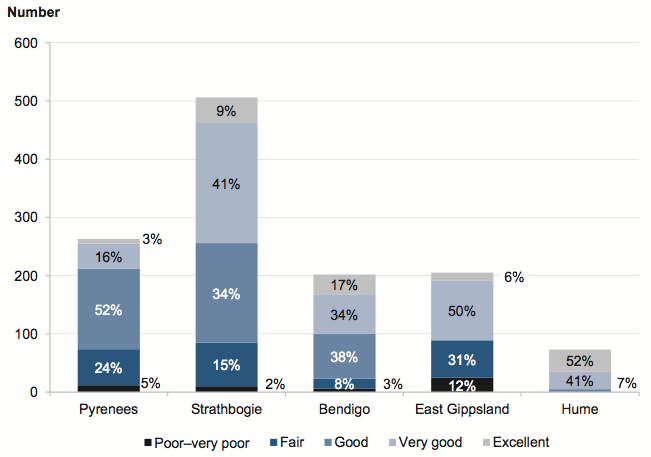
Source: Victorian Auditor-General’s Office.
East Gippsland has not completed level 2 condition assessments of bridges on a programmed cycle like other councils. Instead, it has performed assessments if the need is identified in a level 1 routine inspection. East Gippsland has recorded condition ratings for all but four of its bridges, however, it could not provide assurance on the currency of these assessments. In addition, it has not included major culverts in its level 2 condition assessments, with only high-level assessments of culverts being completed to date. This is a significant gap to be addressed in the short-term.
Hume previously completed level 2 condition assessments of its bridges and major culverts in 2004–05. While updated assessments were completed in November 2011, it had fallen short of its aim of doing this type of assessment every five years. The council did rate condition in 2009, but this assessment, based on photographic evidence, did not provide the same level of detail and assurance as a level 2 inspection.
Strathbogie had assessed condition as planned in 2009. We found one example where the assessment appeared inconsistent with a decision in the following year to close a bridge. In 2009 Strathbogie rated Kirwans Bridge as being in fair condition. However, the council closed the bridge in 2010 because a further, detailed investigation found that a range of urgent works were required to keep the bridge open.
The council subsequently spent $50 000 on emergency works and reopened the bridge with a six tonne loading limit while working on a long-term solution. The change in assessments raised doubts about the reliability of the assessments.
Sustaining asset condition
All councils except East Gippsland had forecast, for a 20-year period, the gap between the works required to renew bridges and culverts so they continued to function as they intended and had included in their forward plans. However, only Strathbogie and Pyrenees demonstrated that they had linked these renewal levels into their long-term financial plans.
Figure 3E describes the results for the four councils that have estimated renewal gaps:
- three councils have current shortfalls of between $60 000 and $500 000
- within 20 years, Strathbogie expects to have eliminated its shortfall and the remaining three councils are forecasting gaps of between $1 million and $2.8million.
Strathbogie alone has plans that, if applied, would effectively close the renewal funding gap. Hume, Pyrenees and Bendigo are forecasting a growing bridge renewal gap.
East Gippsland could not produce reliable forecasts because its four-point condition rating scale is not compatible with its method for modelling bridge renewal gaps. The council needs to address this deficiency and is planning to complete bridge and culvert condition assessments that will allow it to do so.
All councils need to be clear about what level of bridge renewal they intend to fund by reflecting these commitments in their long-term financial plans. Those councils forecasting a shortfall in renewal funding need to convey the impacts on condition and customer levels of service to the community and be clear about how they will manage the service risks.
Figure 3E
Current and projected bridge renewal gap
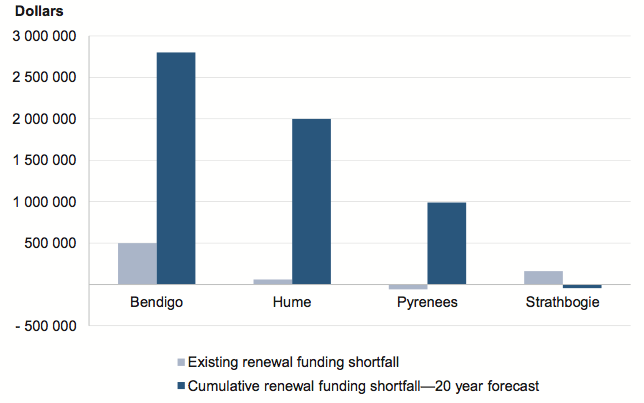
Source: Victorian Auditor-General’s Office.
Current renewal gaps are small in relation to councils’ annual capital expenditure, revenue income and bridge replacement costs. In terms of bridge replacement costs:
- Bendigo—$500 000 renewal gap is equivalent to 0.01 per cent of the replacement cost of $65.9 million
- Hume—$60 000 renewal gap is equivalent to 0.003 per cent of the replacement cost of $22.4 million
- Strathbogie—$160 000 renewal gap is equivalent to 0.005 per cent of the replacement cost of $33.7 million
- Pyrenees—$60 000 renewal surplus is equivalent to 0.002 per cent of the replacement cost of $33.4 million.
Recommendations
Councils should:
- define bridge levels of service that capture the outcomes that are important to road users and incorporate associated targets and measures in their plans
- publish information that will allow the community to understand councils’ performance in terms of the past and forecast costs and service outcomes
- address the information and process weaknesses identified in this report.
Appendix A. Audit Act 1994 section 16—submissions and comments
Introduction
In accordance with section 16(3) of the Audit Act 1994 a copy of this report was provided to VicRoads, the City of Greater Bendigo, Hume City Council and the shires of East Gippsland, Pyrenees and Strathbogie with a request for submissions or comments.
The submission and comments provided are not subject to audit nor the evidentiary standards required to reach an audit conclusion. Responsibility for the accuracy, fairness and balance of those comments rests solely with the agency head.


